

Facts about the Muslims & the Religion of Islam - Toll-free hotline 1-877-WHY-ISLAM. By Saulat Pervez Hijab In Islam In the Name of God, the Most Gracious, the Most Merciful Islam’s code of modesty extends to all aspects of one’s life, including attire.
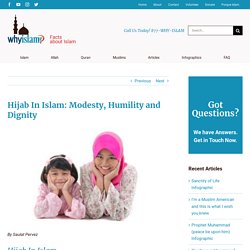
Hijab, the head-covering worn by Muslim women, is an outer manifestation of an inner commitment to worship God. BBC - Religions - Islam: Hijab. Headscarf muslim. Rakat - The nature of God - GCSE Religious Studies Revision - WJEC - BBC Bitesize. Hijab. Veil worn by Muslim women In the Qur'an, hadith, and other classical Arabic texts the term khimār (Arabic: خِمار) was used to denote a headscarf, and ḥijāb was used to denote a partition, a curtain, or was used generally for the Islamic rules of modesty and dress for females.[6][7][8][9] In its traditional form, it is worn by women to maintain modesty and privacy from unrelated males.
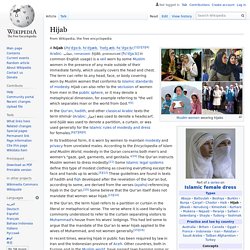
According to the Encyclopedia of Islam and Muslim World, modesty in the Quran concerns both men's and women's "gaze, gait, garments, and genitalia. What does the Quran really say about a Muslim woman's hijab? 2016 Census: Religion. 2016 Census data reveals “no religion” is rising fast The results of the latest national Census today reveal we’re a religiously diverse nation, with Christianity remaining the most common religion (52 per cent of the population).

Islam (2.6 per cent) and Buddhism (2.4 per cent) were the next most common religions reported. Nearly a third of Australians (30 per cent) reported in the Census that they had no religion in 2016. The religious makeup of Australia has changed gradually over the past 50 years. In 1966, Christianity (88 per cent) was the main religion. Australia is increasingly a story of religious diversity, with Hinduism, Sikhism, Islam, and Buddhism all increasingly common religious beliefs. The growing percentage of Australia’s population reporting no religion has been a trend for decades, and is accelerating. How likely a person was to identify as religious in 2016 had a lot to do with their age.
Australian Statistician David W. Census data is available free online. Rise Up Australia » Australian Federal MPs call to Reform Islam. 1st December 2015 Several Federal MPS in a surprisingly encouraging move have called on a genuine debate to reform Islam.
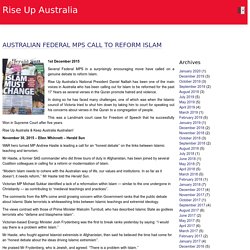
Christian women are wearing hijabs in solidarity with Muslims during Ramadan. Non-Muslim women across the world are wearing the hijab for 30 days as part of the Ramadan Hijab challenge.

The initiative was created by the World Hijab Day organisation, and encourages non-Muslim women to don a head scarf and fast for the Holy Month of Ramadan. This event is for those who want to experience the hijab for more than just one day in order to better understand what Muslim women go through on a daily basis. Eleven-year-old Grace Lloyd has chosen to wear a black hijab to her school in Doha. Lloyd, who is not a Muslim, says she “feels very strongly” about it, and plans on wearing it the entire month. Islam in the Media 2017 - OnePath Network. The beauty of prayer in Islam.
Brandon Yusuf Toropov gives a vivid account of his personal quest to study the most authentic verses of the Bible — the Q verses — and his coming into the fold of Islam.

Thhis is the concluding part of his story. I WAS interested in the research being done that indicated that the oldest strata of the Gospels reflected an extremely early oral source known as Q (the Q source: Q from German, Quelle, meaning ‘source,’ is a hypothetical written collection of Jesus’s sayings) and that each of the individual sayings of Jesus (may the mercy and blessings of God be upon him) needed to be evaluated on its own merits, and not as part of the narrative material that surrounded it. This is because that narrative material was added many years later.
Prayer in Islam. Prayer is one of the five pillars of Islam.
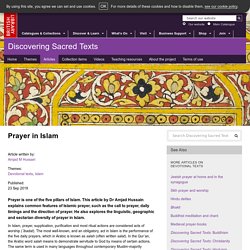
This article by Dr Amjad Hussain explains common features of Islamic prayer, such as the call to prayer, daily timings and the direction of prayer. He also explores the linguistic, geographic and sectarian diversity of prayer in Islam. In Islam, prayer, supplication, purification and most ritual actions are considered acts of worship (ʽibadat). The most well-known, and an obligatory, act in Islam is the performance of the five daily prayers, which in Arabic is known as salah (often written salat). In the Qur’an, the Arabic word salah means to demonstrate servitude to God by means of certain actions. Prayer Book from Ghana This is a finely scribed and illuminated West African copy of the Dalāʾil al-Khayrāt, a popular prayer book by the Moroccan author Muḥammad Ibn Sulaymān al-Jazūlī. View images from this item (3) Usage terms Public Domain in most countries other than the UK.
Prayer book from Aceh. Should Australia ban the burqa? Attorney-General George Brandis ruled out a burqa ban, declaring it was vital for intelligence and law enforcement agencies to work cooperatively with Muslim communities to prevent terrorism.
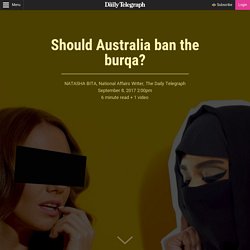
“To ridicule that community, to drive it into a corner, to mock its religious garments, is an appalling thing to do,’’ he thundered, to applause from Labor and the Greens. The Koran decrees that men and women should “cover and be modest’’ – yet interpretations of the Islamic scripture differ widely. A Muslim girl's story: what does it mean to wear a hijab in Australia? - MOJO News. Syakinah has worn a hijab since she was 10.
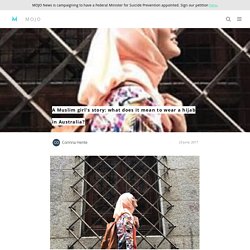
But why do women choose to cover themselves with a veil? Is it a choice or are they wearing it out of parental expectation? NIK IZZA IMAN looks at the conflicted world of the young generation of veiled Muslims in Australia. By NIK IZZA IMAN Syakinah Idham was told to put on a hijab at age 10. The first time she wore it to school, she remembers the looks her classmates gave her when she stepped into class. At 11, Syakinah left her home country of Malaysia and moved to Australia with her mother for her work. She was scared about the move, she says – afraid of being judged, of not being accepted and of being a minority. And it was. It wasn't the last time something like that happened. “He asked me at first why I was wearing this thing, he pointed at my hijab and told me to take it off,” she says. “I told him because of my faith for my God.
“I did ask my parents once as to why I’m wearing the hijab,” she says. “It’s always hard being a newbie. Kevin Dunn media release.